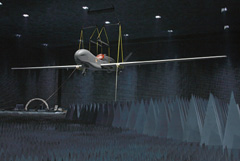
| Testing Studies Global
Hawk's Electromagnetic Profile |
|
|
7/14/2008 - EDWARDS AIR FORCE BASE, CA -- The Global Vigilance Combined Test Force concluded an electromagnetic profile study for the Global Hawk Block 20 at the Benefield Anechoic Facility here July 3. The three-week study marked the first time the test force used an entire Global Hawk aircraft for testing inside the anechoic facility. "With this testing, we want to identify the electromagnetic profile of the Global Hawk, see if there are any electromagnetic incompatibility issues and verify that the aircraft is electromagnetically compatible with itself," said John Hafer, Northrop Grumman project manager. The anechoic facility provided a unique and controlled environment for this testing, said 2nd Lt. Christopher Stilson, 772nd Test Squadron project lead engineer. "We are testing the aircraft at the BAF because we have a sealed chamber, which allows no radio frequency to come into or go out of it," Lieutenant Stilson said. "We are completely sealed off from the outside world and interferences, such as cell phones and radios, which sometimes make it hard to separate the aircraft's radio frequency from the environment." In the past, the combined test force performed testing inside the chamber with only parts of the Global Hawk, including a fuselage. "Now, we have the whole aircraft," said Thomas Stiles, 452nd Flight Test Squadron global vigilance project manager. "We are trying to get the profile configuration of all the aircraft, and the only way to do that is to get the complete aircraft inside." The team performed antenna coupling, radiated emission tests and transient emission tests. "We turned on the electronic equipment inside the aircraft, applied power and made sure everything was up and running the way it normally operates," Mr. Hafer said. "Antennas were placed around the aircraft to record and measure all the emissions being generated by the aircraft." Another set of antennas was also placed around the aircraft to generate electromagnetic fields at high amplitude. "We were trying to hit the aircraft with as much power as possible and make sure that none of the aircraft systems was affected by that power," Lieutenant Stilson said. Antenna coupling testing determines how well the antenna isolates its signal from other radiated signals. With transient emission testing, the testers looked at the effects of the interference of the aircraft's power lines. The result of this testing is part of the Federal Aviation Administration requirement for the Global Hawk's airworthiness certification. "It is a certificate required by the FAA to allow an air vehicle to fly in the national airspace," said Ed De Reyes, Northrop Grumman EMI Test Lead. "Because the Global Hawk is an unmanned aerial vehicle, the FAA is requiring a higher standard for the aircraft." A great amount of preparatory work was performed for this testing. Organizations involved included the 452nd FLTS and the 772nd TS from Edwards; Northrop Grumman; and the Global Vigilance CTF and the 303rd Aeronautical Systems Group from Wright-Patterson Air Force Base, Ohio. "We have been working on this project for about a year," Mr. Stiles said. "This is a collaborative effort. During the entire time, people were going above and beyond to complete this testing. We couldn't have done it without teamwork." Source: USAF Edwards AFB Press Release by Senior Airman Julius Delos Reyes |
| |
